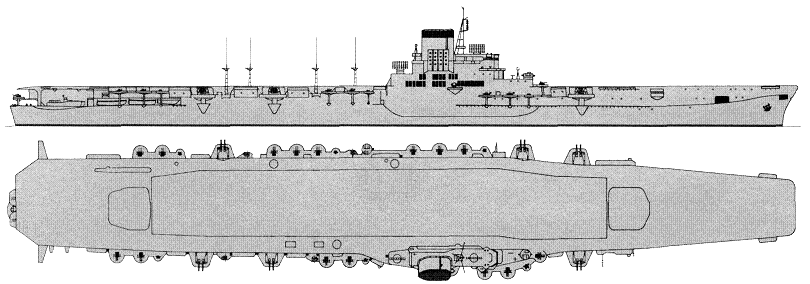

Taiho 1944
| Name | No | Yard No | Builder | Laid down | Launched | Comp | Fate |
| 大鳳 [Taiho] | Kawasaki, Kobe | 10.7.1941 | 7.4.1943 | 7.3.1944 | sunk 19.6.1944 |
|
Displacement standard, t |
29300 |
|
Displacement full, t |
37720 |
|
Length, m |
238.0 pp 253.0 wl 260.0 oa |
|
Breadth, m |
27.7 wl 29.9 fd |
|
Draught, m |
9.59 |
|
No of shafts |
4 |
|
Machinery |
4 sets Kampon geared steam turbines, 8 Kampon boilers |
|
Power, h. p. |
160000 |
|
Max speed, kts |
33.3 |
|
Fuel, t |
oil 5700 |
|
Endurance, nm(kts) |
8000(18) |
|
Armour, mm |
belt: 55 (165 - 150 abreast magazines), flight deck 79, lower hangar deck 90 - 48 |
|
Armament |
6 x 2 - 100/65 98-shiki, 17 x 3 - 25/60 96-shiki, 84 aircraft (A6M fighters, D3A, D4Y diving bombers, B5N, B6N torpedo bombers, C6N recon planes) |
| Electronic equipment | 2x 1-shiki 2-go, 3-shiki 1-go radars |
|
Complement |
1751 |
Aircraft facilities (fd - 7,693m², ha - 6,840m² / 34,200m³): Flight deck: 257.5x29.9m. Upper hangar: 152.0x22.5x5.0m, lower hangar: 152.5x22.5x5.0m. There were fore (14.0x13.6m, 5.5t) and aft (14.0x14.0m, 5.5t) lifts. Aircraft fuel stowage: 1400t.
| Year | fighters | diving bobers | torpedo bombers | recon planes |
| 3.1944 | 27 A6M5 | 27 D4Y1 | 18 B6N | 3 D4Y1C |
Project history: Most powerful and perfect carrier of IJN. Her designing has begun in 1939, according to 4th Supplementary Programme. Originally the ship reflected as enhanced Shokaku, however in the course of design efforts she was transformed to absolutely new project of the ship with armoured flight deck: some kind of answer to occurrence of British Illustrious and American Essex classes. The construction of Taiho contained many foremost decisions. Flight deck represented an integrated part of hull and participated in providing of its longitudinal strength. The bow has been fulfilled full closed: Japanese have applied such decision for the first time. Atypically for Japanese Navy island on the big sponson with raked funnel, created on similarity to Junyo, looked also.
Horizontal protection included 95mm flight deck (76mm protection on 19mm shipbuilding steel plating) over the upper hangar and 48mm (32 + 16) lower hangar deck; over magazines deck thickness increased to 40-90mm. Hangar sides had 25mm thickness. Upper hangar deck was not protected. 55mm belt covered only hardly more than 50% of hull length; on height it reached lower hangar deck. Local protection of magazines, tanks of aviation petrol and two steering compartments was strongest (to 165mm).
Under the 1942 Programme it was supposed to build seven more a few advanced aircraft carriers of Taiho class (G-15 design) with increased area of flight deck (261.5õ29.9m). Two ships were ordered to Kawasaki (No801 and 802) and five to Mitsubishi (No5021-5025). However war and economic situations forced Japanese to refuse this planes.
Ship protection: Main 55mm belt protected about half of hull length. It connected with lower hangar deck. Hangars sides had 25mm protection. Thickness of lower hangar deck was 48mm (32mm armor on 16mm plating) increasing to 90mm over magazines. Flight deck had 95mm (76mm armor on 19mm plating) thickness over hangar. Lifts had 50mm protection. Magazines had 165-70mm, aircraft fuel tanks 85-50mm and steering gear 125-50mm local vertical protection. Underwater protection included 76mm longitudinal bulkhead. Funnel uptakes were protected by 25mm armor.
Modernizations: none.
Naval service: In the morning 19.6.1944 during battle at
Mariana Islands Taiho has received torpedo hit from
American submarine Albacore to starboard fwd part. As a result of
leaking of steams of aviation petrol in six hours after attack there was an explosion, and
carrier has sunk.

Taiho
© Ivan Gogin, 2008-14